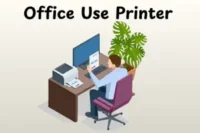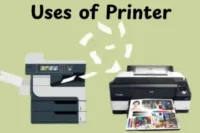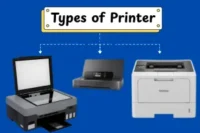Advantages and Disadvantages of Printer Explained Simply
Published: 16 Oct 2025
A printer is a device that helps you to print digital information on paper. It is used to print papers, images, and other materials at home, school, and in the office.Learning about the types of printer is important because each one offers different features and functions. Knowing the advantages and disadvantages of printers helps because it lets you select the best one to avoid issues. This article will cover the key benefits, drawbacks and tips for using a printer successfully.
Advantages of Printer
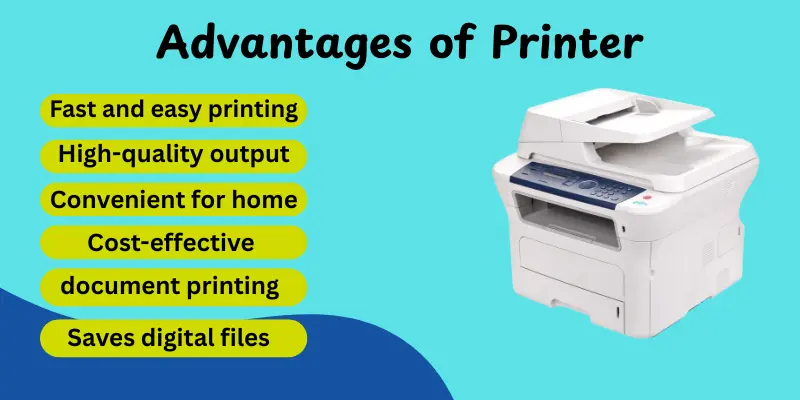
Printers simplify daily tasks by converting digital information into physical copies that can be used, shared, and stored. They save time, increase productivity, and help with a variety of personal and professional activities. Having a printer allows you to print from the computer, reducing the need to visit a printing business. Here are some benefits of printer:
- Fast and easy printing
- High-quality output
- Convenient for home and office use
- Cost-effective for frequent printing
- Supports photo and document printing
- Reduces dependence on print shops
- Allows bulk printing at once
- Easy to connect with computers or Wi-Fi
- Saves digital files as hard copies
- Enhances productivity and organization
1. Fast and Easy Printing
Printers help you to have your papers ready in just a couple of seconds. You can print a large number of pages easily and without waiting long. This is useful to colleges, offices, and companies. It makes regular activities faster and easier.
- Saves time when printing large files
- Reduces waiting time for urgent work
- Helps complete tasks quickly
2. High-Quality Output
Modern printers produce bright, clear prints. Photos are bright, and writing is clear and simple to read. This quality is important for reports, designs, and presentations. It gives a professional touch to your work.
- Delivers clear and accurate colors
- Improves the look of documents
- Perfect for business and school projects
3. Convenient for Home and Office Use
Printers could be used almost anywhere, both at home and business. You can print assignments, forms, and photographs any time you want. Having one close to you saves you trips to the print shop. It’s a useful tool for daily tasks.
- Always available when you need prints
- Works for both personal and professional use
- Saves travel time and printing costs
4. Cost-Effective for Frequent Printing
If you print often, having a printer saves money. You don’t have to pay per page at printing shops. Bulk printing at home or in the workplace reduces overall expenses. It’s a good long-term investment.
- Saves money over time
- Useful for students and offices
- Reduces cost per page
5. Supports Photo and Document Printing
Printers can handle both pictures and normal papers with ease. You may use the same device to print family photos, creative designs, and office files. It also makes printing more enjoyable and useful.
- Handles different types of files
- Great for creative and official work
- One device for all printing needs
6. Reduces Dependence on Print Shops
Having a personal printer means you don’t have to go to the print shop every time. Print at your own ease and speed. This saves you time while also making your routine more comfortable.
- Offers full control over printing
- Saves travel and waiting time
- Convenient for quick prints
7. Allows Bulk Printing at Once
Printers can print a large number of pages in one go. This function is ideal for papers, study materials, and event fliers. It speeds up the ending of huge printing projects due to the need for routine effort.
- Prints multiple copies quickly
- Saves effort on big tasks
- Ideal for offices and schools
8. Easy to Connect with Computers or Wi-Fi
Most printers now accept both USB and WiFi connectivity. You can print directly from your laptop, tablet, or phone. It simplifies and speeds up the process for everyone.
- Connects with multiple devices
- No need for cables or setup hassle
- Works with mobile printing apps
9. Saves Digital Files as Hard Copies
Printing provides physical copies of important documents. This helps to keep documents secure and easily available. Even if your computer fails, you will have paper backups.
- Keeps important documents secure
- Useful for legal and school records
- Easy to store and organize
10. Enhances Productivity and Organization
Printers help you keep organized by offering fast access to necessary documents. Print plans, notes, and task lists to help you manage your time more effectively. It helps you focus and work more efficiently.
- Keeps tasks well-planned
- Helps manage work easily
- Boosts daily productivity
Disadvantages of printer
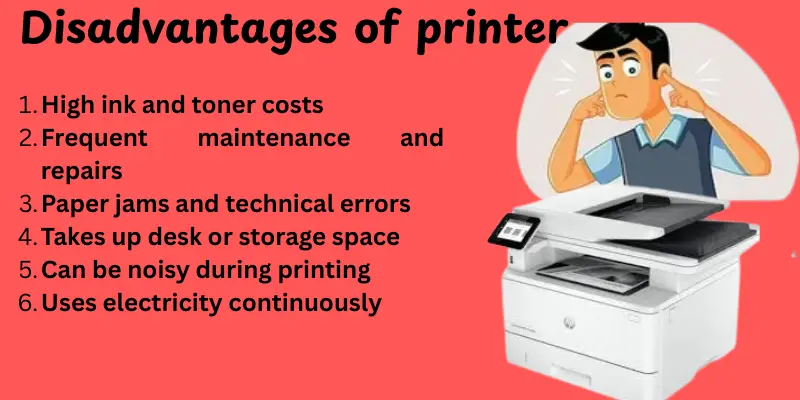
While printers are very useful, they can have some drawbacks. They need ongoing repair, ink, and paper, which may become expensive over time. Printers may experience issues such as paper jams, low speeds, or poor print quality. Understanding those drawbacks of printers helps you to make a better choice before purchasing.
- High ink and toner costs
- Frequent maintenance and repairs
- Paper jams and technical errors
- Takes up desk or storage space
- Can be noisy during printing
- Uses electricity continuously
- Limited portability
- Slow printing speed at times
- Not easily portable
- Causes paper and ink waste
1. High Ink and Toner Costs
Printer ink and toner may be very expensive. They often run out rapidly, especially when used often. Changing them gradually increases your printing costs. This makes long-term use expensive for students and businesses.
- Ink and toner need regular replacement
- Increases monthly expenses
- Not ideal for heavy printing use
2. Frequent Maintenance and Repairs
Printers require regular service to continue working smoothly. Dust, paper jams, and old components can all cause problems. Sometimes repairs need both time and money. Without regular maintenance, the printer can stop working correctly.
- Requires regular cleaning
- Repairs can be costly
- Breakdowns slow down work
3. Paper Jams and Technical Errors
Paper jams are one of the most common issues with printers. They can quickly stop your work and waste paper. It may be difficult and time-consuming to fix these jams. Technical faults might also cause delays.
- Wastes time and paper
- Interrupts printing tasks
- Needs manual fixing often
4. Takes Up Desk or Storage Space
Printers, especially models designed for offices, may be large. They take up valuable desk or shelf space. This might be an issue in small rooms or common spaces. Finding a suitable location for them is sometimes difficult.
- Not suitable for small spaces
- Limits working area
- Hard to move once placed
5. Can Be Noisy During Printing
Some printers produce loud sounds during printing. This can disturb others in peaceful areas or workplaces. Large print work creates more noise. It might be difficult if used frequently.
- Disturbs focus during work
- Not suitable for silent environments
- Can be distracting in meetings
6. Uses Electricity Continuously
Printers consume electricity even when they are not in use. Leaving them plugged in increases your electric bill. This makes them less energy efficient than digital options. Turning them off helps, but it takes extra work.
- Raises electricity costs
- Wastes energy if left on
- Not eco-friendly
7. Limited Portability
Printers are not easy to bring anywhere. They need a permanent location and a power supply. Carrying them from one location to another may be difficult and challenging. This limits their usefulness outside of the setup area.
- Hard to move frequently
- Needs stable placement
- Not ideal for travel use
8. Slow Printing Speed at Times
Some printers are slow, particularly when printing images or complex designs. This can cause delays in workplaces or schools. Waiting for huge files to print can be difficult. The printer model often sets its speed.
- Slows down work progress
- Not fit for urgent tasks
- Time-consuming for bulk jobs
9. Not Easily Portable
Printers are often heavy and need careful handling. Carrying them to a different room or location might be challenging. Their connections and setup also make them less portable. Portability is an important issue for regular movers.
- Difficult to transport
- Needs careful handling
- Not designed for travel
10. Causes Paper and Ink Waste
Many people print more pages than necessary, wasting ink and paper. Test printing and errors boost expense. This not only increases prices but also has a negative impact on the environment. Responsible printing helps solve this issue.
- Increases printing costs
- Creates unnecessary waste
- Not environmentally friendly
Helpful Tips for Understanding Printer
- Learn the basics first. Know how your printer works, what kind it is, and what ink it needs.
- Use the right paper. Good paper gives better print quality and prevents jams.
- Keep it clean. Wipe dust and check for paper bits to avoid printing errors.
- Print only what you need. This saves ink, paper, and money.
- Update drivers regularly. It helps your printer run faster and smoother.
- Turn it off when not in use. This saves power and keeps your printer in good shape.
Conclusion
Printers ease life by changing digital data into physical, useful copies. In this article, we explored the key pros and cons of printers, ranging from speed and quality to cost and maintenance. Knowing both sides helps you to make better choices and make better use of your printer. Every printer has advantages and disadvantages, so look at your demands in comparison to your budget. Think carefully before selecting the one that best suits you!
FAQs
Printers make it simple to create physical copies of your work in seconds. They are perfect for printing school projects, office papers, and photographs. Having one at home saves trips to the print shop. Also, you may print anytime you want without waiting.
Printers can be expensive to maintain due to ink and paper costs. They also require regular cleaning and maintenance to function properly. Paper jams and missed printing may result in delays. Some models take up space and generate noise.
Knowing both sides helps you make a smart choice before buying one. It shows what to expect in everyday use and how to solve typical difficulties. Understanding the benefits and limitations saves time and money. It’s the best way to select a printer that meets your requirements.
For easy activities, use draft setting or black-and-white printing to save ink. Keep your printer clean and turned off when not in use. Use high-quality paper to remove jams and reduce cost. A little cleaning will help your printer last longer.
Yes, if you print often or need physical copies for work or study. Printers offer ease that internet services don’t always match. They save time when you want fast printouts. But, if you often print, using a print shop may be better.

- Be Respectful
- Stay Relevant
- Stay Positive
- True Feedback
- Encourage Discussion
- Avoid Spamming
- No Fake News
- Don't Copy-Paste
- No Personal Attacks

- Be Respectful
- Stay Relevant
- Stay Positive
- True Feedback
- Encourage Discussion
- Avoid Spamming
- No Fake News
- Don't Copy-Paste
- No Personal Attacks


